[Go here for 2014 data and the rest of the survey results]
2015 Merit Increases
A mere 13.8% (down from 14.1% in 2013) of survey participants have decided and/or approved their pay budgets for 2015, leaving 86.3% undecided as of the end of June.

Of those who have decided, on average across all employee types, 14.3% (down from 17.8% last year) of the employers expect to offer 2015 merit increases of up to 2.5%, 48.8% plan no increase, 41.7% (up from 29.6% last year) plan to offer merit increases of 2.5–5%, and 5.2% (up from 3.5% last year) plan to offer increases above 5%.
The breakdown of employee types shows 14.9% of employers plan merit increases of up to 2.5% for senior management, 18% plan that amount for management, 13.6% plan it for nonmanagement salaried exempt employees, 12.5% plan the same for hourly office employees, and 12.4% plan to award up to 2.5% of base pay as an increase to hourly nonoffice employees. Among employers planning merit increases for 2015, the most common amount is 2.5–3% for exempt nonmanagement employees and 3.01–3.50% for senior management, management, and hourly nonoffice employees.
2015 General Increases

Of those who have decided their pay budget for 2015, on average across all employee types, 16.9% (down from 22.2% last year) of the employers expect to award general increases of up to 2.5%, 15.5% (down from 17.2% last year) plan to offer general increases of 2.5–5%, 5.5% (up from 4.2% last year) plan to award above 5%, and 62.1% (up from 56.5% last year) plan no general increase.
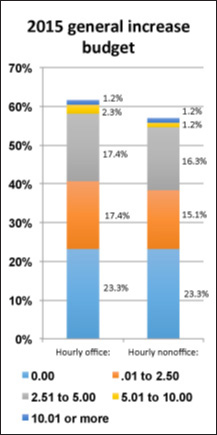
The breakdown of employee types shows 17.2% of employers plan merit increases of up to 2.5% to senior management, 18.4% plan that amount for management, 16.1% plan it for nonmanagement salaried exempt employees, 17.4% plan the same for hourly office employees, and 15.1% plan to award up to 2.5% of base pay as an increase to hourly nonoffice employees. Among employers planning general increases for 2015, the most common amount is 2.51–3% for exempt nonmanagement employees, management, and hourly employees. It is 2.01–2.50% for senior management.
2015 Maximum Individual Increases
Approximately 7.5% of survey participants indicated their plans for maximum individual increases in 2015. Of that group, on average, 16.5% plan to award a maximum increase of up to 2.5% and 31.4% plan a maximum of 2.51–3% as their individual increase while an average of 14.9% plan 5.01–10% of base pay, and 4.6% plan more than 10% of base pay. At 12%, senior management employees are the largest employee group receiving individual increases of more than 10%.
2015 Rate Range Adjustments
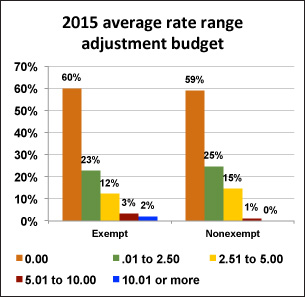
Of the 7.1% of survey participants that answered the question, on average across all employee types, 59.6% (down from 61.9% last year) plan no rate range adjustments for 2015, 23.5% expect to adjust their rate ranges by up to 2.5%, 13.1% expect to make adjustments of 2.51–5%, 2.5% plan adjustments of 5.01–10%, and 1.3% plan adjustments above 10%.
2015 Bonuses
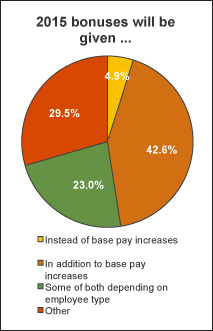
A little under 7% of those responding to our survey provided information regarding their plans for bonuses in 2015. Of those who did, on average across all employee types, 6.3% plan to offer bonuses of up to 2.5% of base pay and 12% plan to offer 2.5–5%. Another 6% plan bonus amounts in 2015 of 5.01–10% and bonus amounts of over 10% are planned for an average of 13.3% of the survey participants who answered this question. Though 4.9% (down from 7.9% last year) plan to award bonuses in lieu of pay increases, 42.6% (up from 34% last year) will award bonuses in addition to salary increases, and 23.9% plan some of both depending on employee type.
Compensation.BLR.com, now thoroughly revved with easier navigation and more complete compensation information, will tell you what’s being paid right in your state–or even metropolitan area–for hundreds of jobs. Try it at no cost and get a complimentary special report. Read More.
Pay Practices
The most important factors that affect pay increases include performance (33.5%), company profits (28.3%), and competitors’ wage rates (7.5%). Coming in at 0.4%, department or division is the least common factor affecting raises.
The criteria our survey participants use to determine rate range adjustments include survey of benchmark jobs at 53.8%, company profit at 18.1%, inflation rate at 6%, and consumer price index and company history at 5.4% and 5.2%, respectively.
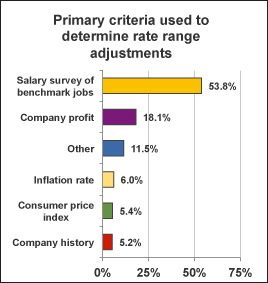
When it comes to assigning a salary range for a new position, our survey participants use a variety of methods. For example, 65.7% compare the new position to other positions within the company and 59.3% research location, industry, and position salary data. Only 23.8%, however, consider the chosen applicant’s previous salary.
Our survey participants use a wide range of sources for salary data, including:
- Trade associations, 21.5%
- Consultants, 15.4%
- Bureau of Labor Statistics, 11.1%
- Salary.com, 9.4%
- BLR, 4.6%
- Economic Research Institute, 3.9%
- Online recruiters, 2.7%
- O-Net Online, 2.6%
- Other, 28.8%
HR professionals fulfill many roles when it comes to setting raises. For example, 7.4% of survey participants who answered this question help supervisors with tough pay decisions and 37% play a major role in deciding the companywide level for raises. Each department’s raises are reviewed by 7.2% and 6.2% approve each employee’s salary increase. Employee raises are determined by 2.4% and 19.1% play no role in setting raises at their organization.
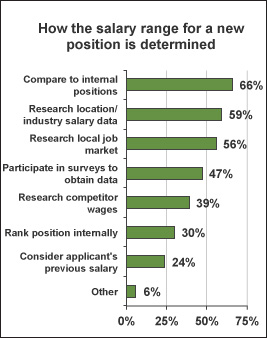
To address employee retention problems, 57.6% evaluate their pay scale/rate range levels to ensure market competitiveness and 33.2% evaluate employees for flight risk, addressing pay issues at the individual employee level. No compensation-related problems are the norm for 17.8% of survey participants.
Participants and Demographics
A total of 1,130 individuals participated in this survey, which was conducted in June 2014. Of those who identified themselves, 56.2% are private for profit, 24.2% are private not-for-profit, and 19.6% are public sector.
Companies with 1–250 employees are represented by 60.9% of survey participants and organizations with 251–500 employees account for 13.5%. Employers with 501–1,000 employees are represented by 9.2% of survey participants, those with 1,001–5,000 are represented by 10.7%, and organizations with more than 5,000 employees are represented by 5.6% of survey participants.
A hefty 45.3% have a workforce that is 1–25% exempt as defined by the FLSA, 25.6% have a workforce that is 26–50% exempt, and 23.4% have a 50–100% exempt workforce. Only 11.5% of survey respondents have a workforce of more than 50% union employees.
Over half (60.7%) of the participants are in service industries; 21.6% are in agriculture, forestry, construction, manufacturing, or mining; 7.9% are in wholesale, retail, transportation, or warehousing; 2.9% are in real estate or utilities; and 6.9% are in public administration.
Staff-level employees account for 13.9% of the survey participants who self-identified. Supervisors account for 3.5% and managers account for 33.8%. Director-level employees account for 29.6% and vice president or higher round out the field at 19.3%.
Thanks again to all who participated! Here is some more detailed information:
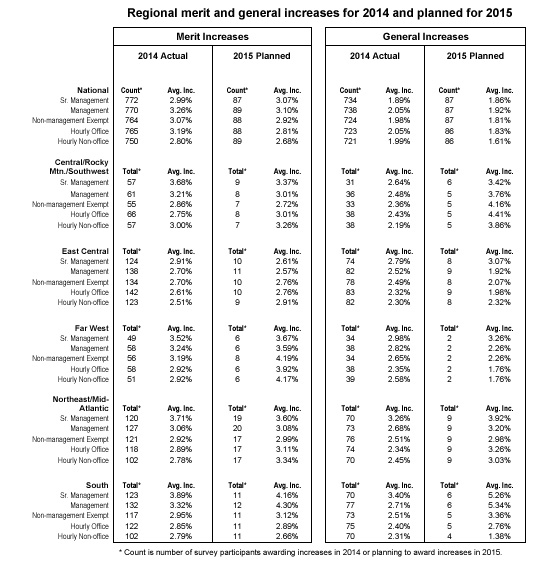

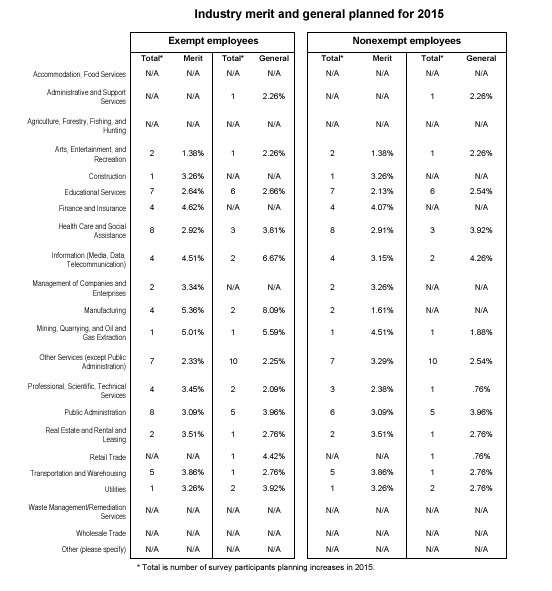
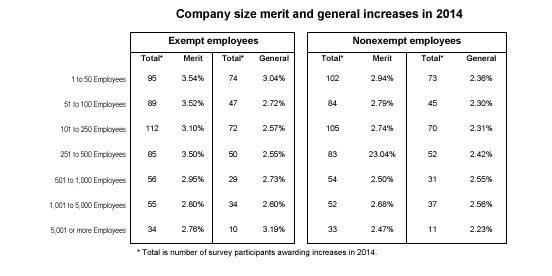
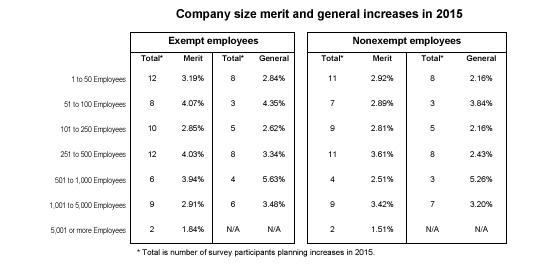
Thanks again to everyone who participated!
“Maintain internal equity and external competitiveness and control turnover, but still meet management’s demands for lowered costs.” Heard that one before?
Many of the professionals we serve find helpful answers to all their compensation and benefits questions at Compensation.BLR.com®, BLR’s comprehensive compensation website.
And there’s great news! The site has just been revamped in two important ways. First, compliance focus information has been updated to include the latest on COBRA, Lilly Ledbetter, and the FMLA. Second, user features are enhanced to make the site even quicker to respond to your particular needs, such as:
- Topics Navigator—Lets you drill down by topical areas to get to the right data quickly.
- Customizable Home Page—Can be configured to display whatever content you want to see most often.
- Menu Navigation—Displays all the main content areas and tools that you need in a simple, easy format.
- Quick Links—Enables you to quickly navigate to all the new and updated content areas.
The services provided by this unique tool include:
- Localized Salary Finder. Based on reliable research among thousands of employers, here are pay scales (including 25th, 50th, 75th, and 90th percentiles) for hundreds of commonly held jobs, from line worker to president of the company. The data are customized for your state and metro area, your industry, and your company size, so you can base your salaries on what’s offered in your specific market, not nationally.
Try BLR’s all-in-one compensation website, Compensation.BLR.com®, and get a complimentary special report, Top 100 FLSA Overtime Q&As, no matter what you decide. Find out more.
- State and Federal Wage-Hour and Other Legal Advice. Plain-English explanations of wage-hour and other compensation- and benefits-related laws at both federal and state levels. “State” means the laws of your state because the site is customized to your use. (Other states can be added at a modest extra charge.)
- Job Descriptions. The website provides them by the hundreds, already written, legally reviewed, and compliant with the Americans with Disabilities Act (ADA) mandate that essential job functions be separated from those less critical. All descriptions carry employment grade levels to current norms—another huge time-saver.
- Merit Increase, Salary, and Benefits Surveys. The service includes the results of three surveys per year. Results for exempt and nonexempt employees are reported separately.
- Daily Updates. Comp and benefits news updated daily (as is the whole site).
- “Ask the Experts” Service. E-mail a question to our editors and get a personalized response within 3 business days.
If we sound as if we’re excited about the program, it’s because we are. For about $3 a working day, the help it offers to those with compensation responsibilities is enormous.
This one’s definitely worth a look, which you can get by clicking the link below.
Click here to get more information or start a no-cost trial and get a complimentary special report!

